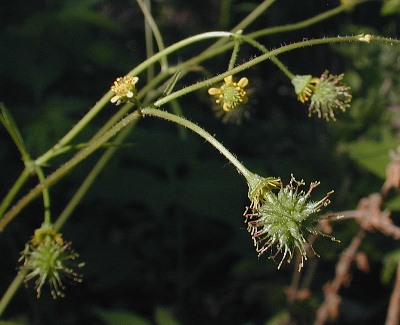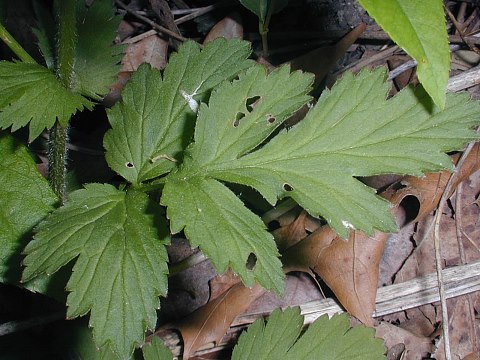Description: This is a herbaceous perennial plant about ½–2' tall that branches occasionally. The stems are light green to pale red, terete, slightly hairy, and shiny. Both basal and alternate leaves are produced. Basal leaves are compound or simple with long petioles; compound leaves are odd-pinnate with 3-7 leaflets. Simple leaves are orbicular, shallowly cleft, and dentate; the leaflets of compound leaves are ovate, shallowly or deeply cleft, and dentate. Alternate leaves are usually trifoliate with short petioles; their leaflets are narrowly ovate, cleft, and dentate. The upper surfaces of these leaves are medium to dark green and hairless to hairy. At the base of each leaf, there is a pair of large leafy stipules; these stipules are deeply cleft and dentate along their margins.

Flowers develop
from the upper stems on long branching stalks; each stalk terminates in
an individual flower about ¼" across. Individual flowers also develop
from the axils of the upper leaves on long unbranched stalks. These
flowering stalks are slightly hairy, shiny, and terete like the stems.
Each flower has 5 yellow petals, 5 light green sepals, and a dense
cluster of pistils and stamens in the middle. The petals are about the
same length as the sepals (less than 1/8" or 3 mm.); the sepals are
ovate and
hang downward from the rest of the flower. The blooming period occurs
from mid- to late spring and lasts about 3 weeks; only a few flowers
are in bloom at the same time. Each flower is replaced by dense cluster
of bristly achenes; the receptacle of this clustered fruit is exerted
from the calyx on a short stout stalk. The individual achenes are
ellipsoid in shape and hairless to pubescent; the hooked bristles at
their tips are persistent styles. The root system is fibrous and
rhizomatous.
Cultivation:
The preference is dappled sunlight to light shade, moist to mesic
conditions, and a rich loamy soil. Most growth and development occurs
during the spring.
Range & Habitat:
The native Spring Avens is common in the southern half of Illinois,
while in the
northern half of the state it is occasional, uncommon, or absent (see Distribution
Map). Habitats include rich deciduous woodlands, open
woodlands, areas along woodland paths, shaped seeps, woodland borders,
and fence rows with woody vegetation. Spring Avens can be found in both
disturbed and undisturbed areas that receive some shade.

Faunal
Associations:
The flowers attract small bees primarily, including little carpenter
bees, Halictid bees, cuckoo bees (Nomada spp.), and
masked bees (Hylaeus spp.); these small bees suck
mostly nectar, although some of the Halictid bees collect pollen for
their larvae. Occasionally, Syrphid flies, Tachinid flies, and other
flies also visit the flowers. The leaves of Spring Avens and other
woodland Geum spp. (Avens) are grazed sparingly by
White-tailed Deer. The bristly achenes can cling to the fur of mammals,
feathers of birds, and clothing of humans. By this means, they are
distributed into new areas.
Photographic Location:
A floodplain woodland in Vermilion County, Illinois.
Comments:
This is the first woodland Geum sp. (Avens) to
bloom in Illinois. Because the yellow petals of its flowers are quite
small and
short-lived, Spring Avens is not very showy. In contrast, its leaves
are moderately attractive and variable in shape. Other woodland species
in this genus include Geum canadensis (White Avens)
and Geum laciniatum (Rough Avens). These species
have flowers with white or cream petals and they bloom a little latter
in the year (late spring to early summer). Unlike other species in the
genus, the bristly fruits of Spring Avens are exserted from their
calyces on short stout stalks. The fruits of other Avens lack these
stalks. Thus, Spring Avens is easily identified by this peculiar
characteristic.